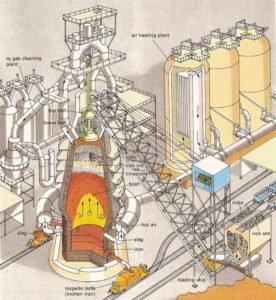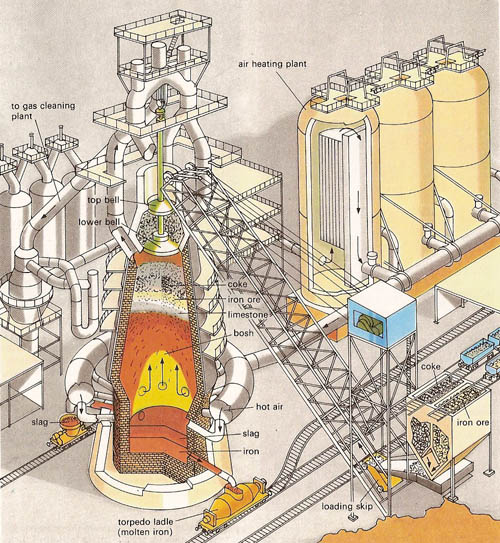How Iron Ore Production In The US Has Changed Over Time: Examining the development of iron ore production in the US reveals an engrossing story of changes in the economy, technology, and environment. A dynamic interaction between industrialization, innovation, and global market forces may be seen in the tale of how iron ore production in the US has changed over time. The United States had modest beginnings in the extraction of iron ore in the early 19th century, with small mining activities satisfying domestic demands. But as the country embraced industrialization, iron demand skyrocketed, catapulting the sector into a revolutionary stage.
A turning point was reached as mining methods advanced to include steam-powered machinery, which allowed for more effective extraction. The path of iron ore production was thereafter affected by changes in the economy, from adjustments made during peacetime to needs during wartime. The US became a significant actor in the world stage during the post-war era, which saw increased vitality. This historical odyssey examines how iron ore production in the US has changed over time in the context of societal, economic, and technological progress.

Quick Navigation
How Iron Ore Production In The US Has Changed Over Time
The landscape of iron ore production has evolved.
Beginning in the 19th century with humble beginnings, the story of how iron ore production in the US has changed over time. At first, localized mining operations served home need. The country’s embrace of industrialization increased the need for iron, which propelled the sector into a revolutionary stage. Production capacity were severely constrained by the labor-intensive and primitive extraction techniques used in the past. Key technological breakthroughs brought about a paradigm shift in the sector over time.
Technological Progress in the Extraction of Iron Ore
Technological advancements were crucial in changing the US iron ore extraction industry’s practices and productivity. An important turning point was the development of steam-powered machinery, which made mining operations more productive and efficient. The scale of iron ore production was greatly expanded by this technological advancement, satisfying the expanding needs of a country that was becoming more industrialized.
Subsequent automation, computerization, and integration of increasingly sophisticated technology increased productivity and efficiency even more. These developments enhanced worker safety conditions in addition to streamlining the extraction process.
External Factors’ Effect on Trajectories
How iron ore production in the US has changed over time has been significantly impacted by external variables like global market dynamics and geopolitical events. The course of the industry was closely linked to fluctuations in the world economy. Iron ore output spikes were frequently the result of periods of geopolitical stability and rising worldwide demand for steel, which was fueled by post-war reconstruction efforts or global infrastructure projects.
On the other hand, the industry encountered difficulties during periods of economic recession or geopolitical unrest, which led to changes in production levels and marketing approaches. The US iron ore production landscape’s susceptibility and adaptability were highlighted by the global market’s interconnection.
Read Also: University of California Riverside | Programs, Admission, History
Reasons for the Demand Increase
There have been spikes in the demand for iron ore in the US during critical historical times for a variety of reasons. Strong demand for iron ore was spurred by the post-war era’s unparalleled economic boom and infrastructural construction. Massive amounts of steel were needed for the construction of buildings, bridges, and highways, which led to an increase in iron ore output to fulfill the nation’s growing needs.
Demands from wartime also had a significant impact, since hostilities demanded more military hardware and infrastructure to be produced. The US iron ore market dynamics and output were significantly impacted by the cyclical nature of demand throughout times of peace and conflict.
Sustainability Practices and Environmental Aspects
Throughout history, there has been a noticeable change in the sustainability and environmental aspects of iron ore extraction. Early on, there were little environmental effect evaluations, and extraction techniques gave efficiency precedence over ecological considerations. Regulations and guidelines were put in place to lessen the ecological imprint of the sector as environmental consciousness increased.
The emphasis on sustainable practices has increased recently. Technologies that lower emissions, cut waste, and encourage ethical mining operations have been adopted by the sector. Iron ore companies’ strategies are more heavily influenced by environmental factors, which is indicative of a larger social movement in favor of sustainable development.
Changes in the Economy and Market Dynamics
The entire production and market dynamics of iron ore in the United States have been significantly impacted by economic movements, including demands during times of war and adjustments during peace. The industry saw a spike in demand during wartime, requiring more manufacturing to keep up with military operations. Adjustments were frequently made in the post-war era as the economy shifted from wartime to peacetime operations.
Economic downturns presented difficulties that resulted in output reductions and industry-wide strategic changes. The US iron ore production landscape’s adaptability to shifting economic conditions demonstrated its resilience in the face of outside forces.
A complex tale of ingenuity, flexibility, and tenacity, the history of how iron ore production in the US has changed over time. The industry’s trajectory has been influenced by several factors such as technological improvements, global market dynamics, environmental considerations, and economic shifts. Iron ore extraction has a crucial part in the historical and economic fabric of the United States, as seen by its persistent evolution.
Read Also: Auckland University of Technology – Total Review, History, Admission & Programs
A Historical Odyssey of the Development of Iron Ore Production in the United States
A fascinating voyage through the annals of industrial history, the story of how iron ore production in the US has changed over time. The iron ore industry’s transformation from its modest origins in the 19th century to its current position as a pillar of the country’s economy is a monument to creativity, flexibility, and the constantly shifting dynamics of international markets.
The Modest Beginnings and the Early Pioneers
Iron ore production in early American history was typified by small-scale mining enterprises that mostly served domestic markets. Even though they were necessary, these procedures had a small scope and required human work for extraction. During this time, the term “how iron ore production in the US has changed over time” is relevant since the sector experienced a significant upheaval from its primitive beginnings.
The Revolution in Technology: A Watershed Moment
An important turning point came with the start of the industrial revolution in the middle of the 19th century. The evolution of iron ore production in the United States was propelled by technological improvements. The extraction process was revolutionized by steam-powered technology, which greatly increased production efficiency by substituting manual work with machines. This development was the first example of how iron ore production in the United States changed over time as a result of technological progress, and it paved the way for the industry’s growth.

Demand Shaping: From Railroads to World Wars
Due to the building of railroads and the booming industrialization that accompanied the country’s westward expansion, the demand for iron ore increased dramatically. In response to these expanding demands, there was a production boom around the end of the 19th century. In this era, the term “how iron ore production in the US has changed over time” is evocative, as the industry has emerged as a crucial driver of economic growth.
Iron ore was in high demand during World Wars I and II as the country prepared for war. The steel industry, which was largely dependent on iron ore, was essential to the development of military hardware and infrastructure during World War II. The sector’s flexibility was on display during these times of increased demand, demonstrating the phrase’s importance in comprehending how the industry reacts to outside influences.
Dynamics of the World Market: A Double-edged Sword
The dynamics of the worldwide market have become more and more entwined with the iron ore business in the second half of the 20th century. The statement “how iron ore production in the US has changed over time” highlights how susceptible the sector is to fluctuations in the global economy. Global steel consumption skyrocketed during periods of economic expansion, pushing iron ore production to all-time highs. On the other hand, economic downturns had a cascading effect that led to industry-wide cuts and tactical alterations.
Environmental Factors: A Contemporary Need
The expression “how iron ore production in the US has changed over time” acquired new meaning as environmental consciousness increased. Early extraction techniques put economics ahead of ecology, and there were little environmental effect studies. But as people’s awareness of environmental issues increased, the business came under more and more scrutiny.
The paradigm has shifted in favor of sustainable methods in the modern era. Today’s iron ore producers incorporate technologies that limit waste, cut emissions, and encourage ethical mining practices. This development highlights the industry’s dedication to striking a balance between environmental care and economic imperatives.
Read Also: The Best Wineries In The World
21st-century Innovation and Automation
Automation and technical innovation are at the vanguard of a new wave of transformation that has emerged in the twenty-first century. The integration of cutting-edge machinery, automation, and computerization is reflected in the statement “how iron ore production in the US has changed over time”. These technologies improve worker safety conditions in addition to increasing productivity.
Resilience in the Economy: Adjusting to Shift
The trajectory of the sector is still being shaped by economic fluctuations, which are a constant element in the story of how iron ore production in the US has changed over time. The iron ore producing landscape’s ability to withstand economic downturns is indicative of its resilience. The industry demonstrates flexibility and adaptability in both responding to wartime demands and navigating peacetime adjustments, so preserving its position as a critical contribution to the economic stability of the country.
An International Player: Transitioning from Regional to Global Importance
The US has become a significant worldwide player in the iron ore market in recent decades. This development is best summarized by the phrase “how iron ore production in the US has changed over time”. Previously a buyer of iron ore, the country has grown to be a major exporter, adding to the world’s supply chain. This change demonstrates the industry’s expansion as well as its influence on the global economy.
Recommended:
- Business Academy Southwest (Erhvervsakademi Sydvest) | Total Review
- Zealand Institute of Business and Technology | History, Admission, Programs
- Metropolitan University College | History, Admission, Total Review, Programs
- Considerations when choosing a Postgraduate Degree in Education
Additionally: Iron Ore Production In The US
The story of iron ore production in the United States has many facets and is marked by creativity, flexibility, and tenacity. The sector has experienced revolutionary transformations, from the humble beginnings of regional mining to the integration of cutting-edge technologies. The sentence “how iron ore production in the US has changed over time” unifies the various historical periods of the industry. It is a narrative thread. The landscape of iron ore production keeps changing as the country negotiates the opportunities and challenges of the future, leaving a lasting impression on the fabric of the American economy.
SEE ALSO:
Trust you found our article on How Iron Ore Production In The US Has Changed Over Time helpful. Follow our website for more interesting articles.

